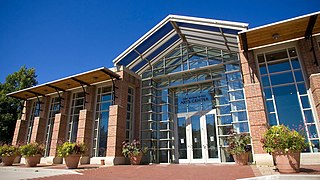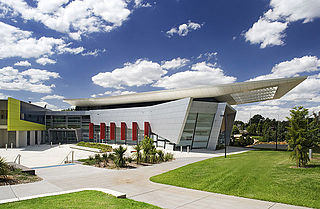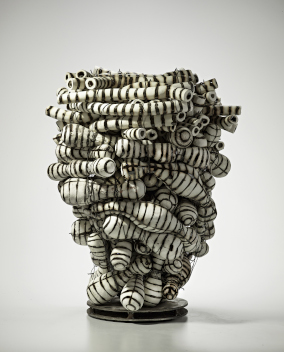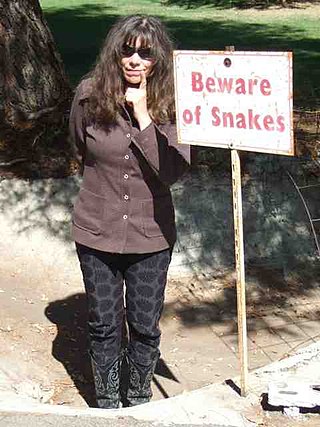
The John Michael Kohler Arts Center is an independent, not-for-profit contemporary art museum and performing arts complex located in Sheboygan, Wisconsin, United States. The center preserves and exhibits artist-built environments and contemporary art. In 2021, the center opened the Art Preserve, a satellite museum space dedicated to art environments.

Patrick Earl Hammie is an American visual artist and educator best known for his large-scale portrait and nude paintings of allegorical subjects. Hammie's paintings emphasize movement, color, and sensuality, drawing from art history and visual culture to examine ideas related to cultural identity, masculinity, beauty, and sexuality. Hammie lives in Champaign, where he currently works as an Associate Professor at the University of Illinois Urbana-Champaign.

Campbelltown Arts Centre is a multidisciplinary contemporary arts centre located in Campbelltown, New South Wales, south west of Sydney, Australia. It is a cultural facility of Campbelltown City Council, assisted by other government funding and private sponsorships.

Sergei Isupov is a ceramic artist born in Stavropol, Russia, now living in Cummington, Massachusetts, United States, and Tallinn, Estonia. He was educated at the Ukrainian State Art School in Kiev and went on to graduate in 1990 from the Art Institute of Tallinn in Estonia with Bachelor of Arts and Master of Fine Arts degrees in ceramic art. He has since exhibited widely in both solo and group exhibitions, received numerous awards, and widely collected by museums and private collectors.

Annabeth Rosen is an American sculptor best known for abstract ceramic works, as well as drawings. She is considered part of a second generation of Bay Area ceramic artists after the California Clay Movement, who have challenged ceramic traditions involving expression, form and function and helped spur the medium's acceptance in mainstream contemporary sculpture. Rosen's sculptures range from monumental to tabletop-sized, and emerge out of an accumulative bricolage process combining dozens or hundreds of fabricated parts and clay fragments and discards. Reviewers characterize her art as deliberately raw, both muscular and unapologetic feminine, and highly abstract yet widely referential in its suggestions of humanoid, botanical, aquatic, artificial, even science-fictional qualities. Critic Kay Whitney wrote that her work is "visceral in its impact, violent even, but also sensual and evocative" and "floats between the poles of the comic and the mordant."

Tom Joyce is a sculptor and MacArthur Fellow known for his work in forged steel and cast iron. Using skills and technology acquired through early training as a blacksmith, Joyce addresses the environmental, political, and social implications of using iron in his work. Exhibited internationally since the 1980s, his work is included in 30-plus public collections in the U.S. and abroad. Joyce works in Santa Fe, New Mexico producing sculpture, drawings, prints, photographs, and videos that reference themes of iron in the human body, iron in industry, and iron in the natural world.

The visual arts are art forms such as painting, drawing, printmaking, sculpture, ceramics, photography, video, filmmaking, comics, design, crafts, and architecture. Many artistic disciplines, such as performing arts, conceptual art, and textile arts, also involve aspects of the visual arts as well as arts of other types. Also included within the visual arts are the applied arts, such as industrial design, graphic design, fashion design, interior design, and decorative art.

Mounir Fatmi is a Moroccan artist. His multimedia practice encompasses video, installation, drawing, painting and sculpture, and he works with obsolete materials.

Mary Jo Bole, US, is a sculptor, printmaker, and artist-bookmaker who lives and works in Columbus. Bole has exhibited her works in the United States and Europe. She was a professor of art at Ohio State University.

Ann Agee is an American visual artist whose practice centers on ceramic figurines, objects and installations, hand-painted wallpaper drawings, and sprawling exhibitions that merge installation art, domestic environment and showroom. Her art celebrates everyday objects and experiences, decorative and utilitarian arts, and the dignity of work and craftsmanship, engaging issues involving gender, labor and fine art with a subversive, feminist stance. Agee's work fits within a multi-decade shift in American art in which ceramics and considerations of craft and domestic life rose from relegation to second-class status to recognition as "serious" art. She first received critical attention in the influential and divisive "Bad Girls" exhibition, curated by Marcia Tucker at the New Museum in 1994, where she installed a functional, handmade ceramic bathroom, rendered in the classic blue-and-white style of Delftware. Art in America critic Lilly Wei describes Agee's later work as "the mischievous, wonderfully misbegotten offspring of sculpture, painting, objet d'art, and kitschy souvenir."
Terry Rosenberg is an American artist, known for painting, sculpture, and drawings that reference the body.
Ann Gardner is an American glass artist known for her large-scale sculptural and architectural installations.
Jack Earl is an American ceramic artist and former teacher, known for drawing inspiration from his home state of Ohio to create rural pieces “with meticulous craftsmanship and astute details… to where you could smell the air, hear the silence and swat the flies.” Although his works hint at highly personal, intellectual, and narrative themes in an almost unsettling manner, Earl is “a self-described anti-intellectual who shuns the art world." He is known particularly for using his trademark format, the dos-a-dos : “This art form is like a book with two stories… the two seemingly incongruent images prompt the viewer to fill in the conceptual gap through poetic speculation.” His work often involves dogs or the character “Bill”, who is said to be a combination of Earl’s father-in-law, himself, and others. The titles to his pieces are typically lengthy, stream-of-consciousness narratives that suggest the folk or rural lifestyle. These are intended to add another dimension to the artwork. His work has received a notable response over his decades-long career, especially since he is regarded as “a master at reminding us that within the events we take for granted are moments of never-ending mystery and wonder.” Earl continues to live in Lakeview, Ohio with his wife, Fairlie.
Kevin Blythe Sampson is an American artist and retired police officer living in Newark, New Jersey. He makes sculptures from discarded found objects that act as memorials for various people who have died. He has a studio based out of Newark.
Melissa Stern is an American artist and journalist. Her drawing and sculpture have been exhibited in museums, galleries, private and corporate collections throughout the world. Her art reviews and cultural commentary have been featured in Hyperallergic, the Brooklyn-based digital arts publication. She serves as Art Editor for Posit, a journal of literature and art.

John Himmelfarb is an American artist, known for idiosyncratic, yet modernist-based work across many media. Diverse influences ranging from Miró, Matisse and Picasso to Dubuffet, New York school artists like de Kooning, Guston, and Pop artists inform his work, described by critics and curators as chaotically complex and tightly constructed. He often employs energetic, gestural line, dense patterns of accumulated shapes, and fluid movement between figuration and abstraction, using strategies of concealment and revelation to create a sense of meaning that is both playful and elusive. His work is also unified by "a circulating library" of motifs and organizing structures, such as geographic and urban mapping, abstracted natural and industrial forms, and language systems. Assessing him at mid-career, New Art Examiner’s Andy Argy wrote "Himmelfarb’s art is original […] His unabashed immersion in graphic art, emphasizing drawing over painting, has earned him an important place among artists who make drawings into major aesthetic statements." Himmelfarb next turned to monumental paintings that critic Christopher Moore called joyful, luminous, and frenetic pyrotechnical displays. In 2006, he began to devote considerable studio time to sculpture that curator Gregg Hertzlieb described as an expression of the "human need for play and (our) enduring fascination with metamorphosis and transformation."

Sharif Bey is an African American artist, ceramicist, and professor. He produces functional pottery as well as ceramic and mixed-media sculptures using various forms and textures. His body of work reflects his interest in the visual heritage of Africa and Oceania and contemporary African American culture. With his colorful large-scale bead sculptures, Bey explores the cultural and political significance of ornamentation and adornment.

Beth Katleman is an American artist known for porcelain assemblage sculpture cast from found objects. Her allegorical installations fall within the genre of pop surrealism, combining decorative elements, such as Rococo embellishments and 19th century Toile de Jouy wallpaper scenery, with satirical references to consumer culture, fairy tales and classic literature. Katleman's work is in private and institutional collections and is exhibited internationally, including an installation commissioned by architect Peter Marino for Christian Dior, in the Hong Kong and London flagship boutiques. She lives and works in Brooklyn, New York, and is the recipient of the 2011 Moët Hennessey Prize, a Mid-Atlantic Arts Foundation grant, the Watershed Generation X Award, a Kohler Arts/Industry Fellowship and a residency in Cortona, Italy sponsored by the University of Georgia, Athens. Katleman holds a BA in English from Stanford University, an MFA from Cranbrook Academy of Art and an MBA in Arts Management from UCLA.

Margaret Lanzetta is an American artist who uses abstract & culturally-significant patterns to explore postmodern conditions of fragmentation, migration, and cultural hybridity. Lanzetta engages with a variety of mediums including painting, silkscreen, digital photography and ceramics.
Anderson Ranch Arts Center is a non-profit arts organization founded in 1966 and located in Snowmass Village, Colorado. The center hosts an artist residency program and summer workshops in the months of June, July, August, September and a January workshop intensive. The campus is five acres in size with working studio space in historic buildings for ceramics, painting, printmaking, drawing, photography, sculpture, furniture making and woodworking as well as a digital fabrication lab, library, café, gallery and a lecture hall. The Ranch invites visiting artists, critics and curators year-round.
















